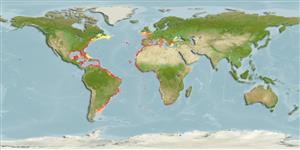Common names from other countries
Environment: milieu / climate zone / depth range / distribution range
Ekologi
marina; brackvatten revassocierade; djupintervall 1 - 100 m (Ref. 26999). Subtropical; 52°N - 45°S, 98°W - 36°E
Eastern Atlantic: English Channel to Angola, including the Mediterranean, Madeira, and the Azores. Western Atlantic: Canada (Ref. 5951) to Massachusetts, USA and the Gulf of Mexico to Argentina.
Length at first maturity / Size / Vikt / Age
Maturity: Lm 19.5 range ? - ? cm
Max length : 50.0 cm SL hane/ej könsbestämd; (Ref. 6544); common length : 38.0 cm TL hane/ej könsbestämd; (Ref. 3397); publicerad maxvikt: 1.8 kg (Ref. 4699)
Short description
Bestämningsnycklar | Morfologi | Morfometri
Taggstrålar i ryggfenan (totalt) : 7; Mjukstrålar i ryggfenan (totalt) : 8; Taggstrålar i analfenan: 0; Mjukstrålar i analfenan: 6. Pectoral fin very large and fan-like, with front 6 rays separated as small lobe (Ref. 26938).
Found on sand, mud or over rocks in sandy areas, exploring the bottom with the free part of the pectoral fins (Ref. 6544). Feeds primarily on benthic crustaceans, especially crabs, clams and small fishes. Neither anterolateral glandural groove nor venom gland is present (Ref. 57406).
Life cycle and mating behavior
Maturities | Reproduktion | Spawnings | Egg(s) | Fecundities | Larver
Eschmeyer, W.N. and L.J. Dempster, 1990. Dactylopteridae. p. 690-691. In J. C. Quero, J. C. Hureau, C. Karrer, A. Post, and L. Saldanha (eds.) Check-list of the fishes of the eastern tropical Atlantic (CLOFETA). JNICT, Lisbon; SEI, Paris; and UNESCO, Paris. Vol. 2. (Ref. 10782)
IUCN Red List Status (Ref. 130435)
CITES (Ref. 128078)
Not Evaluated
Threat to humans
Harmless
Human uses
Fiskeri: mindre kommeriell; sportfisk: ja; Akvarium: Kommersiell
Verktyg
Special reports
Download XML
Internet-källor
Estimates based on models
Preferred temperature (Ref.
115969): 13.3 - 27.8, mean 23.9 (based on 1072 cells).
Phylogenetic diversity index (Ref.
82804): PD
50 = 1.0078 [Uniqueness, from 0.5 = low to 2.0 = high].
Bayesian length-weight: a=0.00977 (0.00739 - 0.01292), b=2.98 (2.90 - 3.06), in cm Total Length, based on LWR estimates for this species (Ref.
93245).
Trofisk nivå (Ref.
69278): 3.7 ±0.5 se; based on diet studies.
Resiliens (Ref.
120179): Mellan, lägsta populationsfördubblingstid 1,4-4,4 år (Preliminary K or Fecundity.).
Fishing Vulnerability (Ref.
59153): Moderate vulnerability (37 of 100).
